This in-depth tutorial will tell you everything you need to know about your telescope’s magnification, and what eyepiece to choose for different celestial targets.
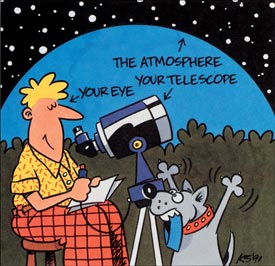
Illustration by Kevin Sartoris / Sky & Telescope
How high or low can you get your telescope magnification? The answers depend on many factors that combine to give each telescope a useful magnification range. This range is not fixed, however, and depends on the nature of eyesight, the telescope's aperture and optical design, atmospheric conditions, and even the type and size of the object looked at.
Consider the complete viewing experience: starlight passes through the atmosphere, through the telescope, and finally into your eyes. Each segment of the journey plays a role in determining the telescope magnification range to use on a given night. Let's take up the segments separately.
Eyesight: Glasses Off or On?
Eyesight is an engineering marvel. Think about it: Our eyes have an automatic iris, automatic focus, an aspheric lens, a curved image surface, a chemical image intensifier, a windshield washer-wiper, and a lens cover, all as standard equipment. And this is without mentioning the wonder of stereo vision!
While our eyes are not perfectly color corrected, our brain processes out the errors. Other defects vary from individual to individual. Fortunately, the common ones can all be compensated when one uses a telescope.
Among the most prevalent defects is astigmatism, which can be ameliorated with eyeglasses or by using only the small central area of our eye's pupil. To see an example of this, make a diamond-shaped aperture by pressing your thumbs and forefingers together. The harder you push them together, the smaller the aperture will become. Now place this opening close to your eye. You will probably see some improvement in resolution and depth of focus. (You may look silly to your companions at the dinner table, but it's great for reading the menu when you forget your glasses.)
Those who suffer near- or farsightedness can simply remove their eyeglasses to use a telescope, since the instrument can be focused to compensate for either defect. Floaters, those bits of debris in our eyes, are mainly a problem when we use magnifications that produce very small exit pupils that accentuate their visibility.
What Telescope Magnification Really Means
There are several important factors to consider with telescope magnification: magnification, true field, apparent field, exit pupil, and resolution.
The first of these is telescope magnification, and by this I mean angular magnification. We see the universe in terms of angles. A 50-power telescope will make the ½° disk of the Moon appear 25° wide.
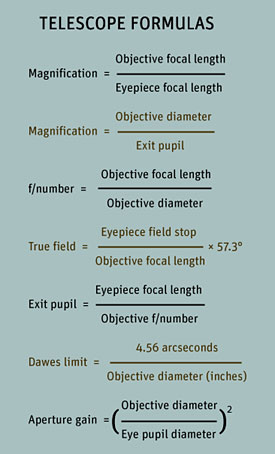
To achieve low telescope magnification, use long-focal-length eyepieces. Telecompressor lenses can shorten the effective focal length of some telescopes, lowering the magnification of a given eyepiece used with that telescope. High telescope magnifications can be obtained by using short-focal-length eyepieces.
Barlow lenses (which can even be "stacked") allow a short-focal-length telescope to achieve absurdly high magnifications. But beware: these high magnifications may not be what we want! The 600-power, 2.4-inch "department store" telescope is a prime example of a malicious turn-off to budding amateur astronomers — the resulting field at that high magnification is too small, too dim, too fuzzy, and too shaky to be of much use.
While an eyepiece's focal length determines the optical system's magnification, the f/number is of little importance visually. A "fast" telescope implies a short focal length and a large field. Fast, however, is a term borrowed from photography (an f/5 telescope can take a photograph with one-fourth the exposure time of an f/10 instrument).
Visually, well-made fast and slow telescopes of the same aperture have no difference in image brightness or resolution. I find that photographers have the most difficulty understanding this concept, because their experience that a faster f/number means brighter images on film and in the viewfinder is so ingrained.
True vs. Apparent Fields
The true field of a telescope is the amount of actual sky we see in the eyepiece. It is determined by the diameter of the field stop (the ring inside the front of the eyepiece that defines the edge of the field) and the focal length of the telescope.
| Focuser size (inches) | 500-mm focal length | 2,000-mm focal length |
| 1¼ | 3.1° | 0.8° |
| 2 | 5.3° | 1.3° |
Eyepieces of very long focus may use the inside edge of the barrel as a field stop. This is why 2-inch eyepieces can have much larger true fields than 1¼-inch eyepieces. The in-side diameter of a typical 2-inch barrel is 1.7 times larger and has three times the area of the smaller barrels. Many eyepieces have field stops that are accessible for measurement by calipers. Others have field stops between the lens elements; such a stop's size cannot easily be used to determine the true field.
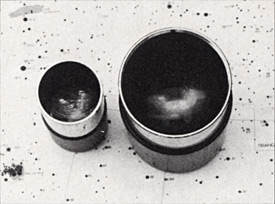
Sky & Telescope
Regardless, you can find the true field of any eyepiece-telescope combination by the star-drift method. Point the telescope at a star near the celestial equator and, with the drive turned off, time the passage of the star centrally across the field. Since equatorial stars appear to move 15 arcminutes for each minute of time, you simply multiply the drift time in minutes of time by 15 to find the true field angle in arcminutes.
A rough approximation to the true field is obtained by dividing the apparent field of the eyepiece by the telescope magnification. It's rough because eyepieces do not magnify linearly across the field, and a factor involving geometric "pincushion" distortion must be applied. Needless to say, this is usually known only to the designer. So use the star drift to determine true field accurately.
While the true field is the actual amount of sky you see through the telescope and eyepiece, the apparent field is the angle of sky that the eyepiece alone sees, and it is what the manufacturer lists with the eyepiece.
If you want to know which of two eyepieces is likely to have a larger apparent field, hold one up to each eye as if you were looking through binoculars. Position them so the field circles overlap, and it will be very clear which circle is larger.
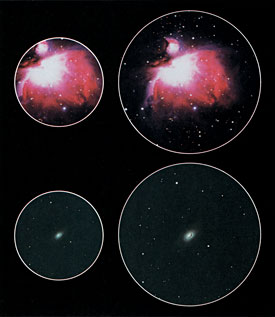
Choosing the Eyepiece Exit Pupil
Exit pupil is the diameter of the beam coming out of the eyepiece. It determines where you place your eye to view the entire field.
You can calculate the exit pupil by dividing the diameter of the objective mirror or lens by the eyepiece magnification. Indeed, binocular makers indirectly specify the exit pupil by specifying the magnification and the aperture. The exit pupil may also be defined by the objective's f/number. For example, an eyepiece of 35-millimeter focal length, when used on an f/5 telescope, will give a 7-mm exit pupil.
High magnifications produce small exit pupils, while low magnifications produce large ones. With very high magnifications and small exit pupils, images (except for stars) grow dim, atmospheric turbulence and shakiness in the telescope's mounting are much more noticeable, and "floaters" (particles inside the eyeball) can be annoying.
On the other hand, one problem can arise from a large exit pupil. If the telescope has a central obstruction, such as the diagonal mirror in a Newtonian or the secondary in a Schmidt-Cassegrain, it appears as a dark spot in the exit pupil with the same relative size that the secondary has to the objective. This shadow is mostly a problem during daytime viewing, when the eye's pupil is smaller. But it's worth noting, as this blockage falls at the center of the eye's pupil and obscures the portion of the eye that performs best.
There is no single best exit pupil for low power or high power; I suggest an eyepiece collection that yields exit pupils of ½, 1, 2, 4, and 7 mm.
Determining Eyepiece (and Telescope) Resolution
Resolution can be defined in many ways. By tradition, telescope manufacturers use the Dawes limit as a specification. During the 19th century in England, Rev. William R. Dawes observed with small refractors and found that he could just distinguish the components of faint double stars of equal magnitude when their separation was equal to 4.56 arcseconds divided by the aperture in inches.
Of course it's just a guideline, since much larger or smaller scopes differ somewhat in performance. Furthermore, resolution is poorer when double stars have components of differing magnitudes.
The Dawes limit tells us nothing about the effects of contrast on resolving planetary details. It also ignores the fact that telescopes with apertures larger than about 9 inches can seldom achieve their theoretical ½-second or better resolution because of bad atmospheric seeing.
Also, if the naked-eye resolution is 1 arcminute (for people with the best eyesight), you only need 120 power to see the resolution limit imposed by either Dawes' formula or the atmosphere. In practice, two or three times that magnification is more comfortable. Any telescope magnification is possible, but I don't believe extraordinarily high powers reveal more than using 300x to 500x on any telescope.
Aperture gain will give you an idea of the faintest stars visible with a telescope. For example, the area gain of a 70-mm aperture over our eye's 7-mm aperture is 100 times. That's equal to a 5-magnitude difference, so if 6th-magnitude stars are visible with the naked eye, then 11th-magnitude stars should be seen in the 70-mm telescope. (This reasoning ignores light loss in the optics.)
The Atmosphere: Transparency vs Seeing
When a deep blue, breezy afternoon turns to a dark and clear night, with stars twinkling brilliantly, we have a night of high transparency. The dark sky and high contrast afford ideal conditions for viewing galaxies, nebulae, and faint stars. Unfortunately the other side of the coin — air turbulence — is often present. On such nights the seeing is often poor. A small telescope shows twinkling stars jumping about playfully, but large apertures average out the motions, giving us steady blobs. Many novice observers are unaware that transparency and good seeing usually avoid one another. The hazy summer doldrums often produce the best seeing and are excellent for revealing double stars and planetary details.
Another factor we must all confront is encroaching light pollution combined with atmospheric haze from industrial pollution. While everyone should pitch in to make our planet cleaner, the immediate answer for an observer is to pack the car and travel to a remote site. It is no coincidence that very portable telescopes, big and small, are becoming more popular, and that star parties are popping up at dark-sky sites all over the country.
Eyepiece Magnification Depends on Target
Before selecting a viewing magnification, consider carefully what it is you are going to be looking at.
If you want to see small and faint galaxies, globular clusters, and faint stars, there is no substitute for aperture. Years ago, big heavy mirrors and long focal ratios were the rule. Eyepieces back then couldn't handle fast f/ratios well. Today, with modern, highly corrected eyepieces and coma correctors, large and compact Dobsonian telescopes can perform as never before, and they're really portable. With 13- to 25-inch Dobsonians, you can use all the power the atmosphere and optical quality will permit. Subject brightness is rarely a limit.
A subject's contrast is sometimes as important as its brightness. Often small refractors outperform larger reflectors because of superior contrast. Increasing the telescope magnification will reduce the size of the exit pupil and darken the background sky. This is why the faintest stars are always seen best with moderately high magnifications.
The contrast of extended objects such as galaxies and nebulae is fixed relative to the sky background and only looks better as you boost magnification because details become more visible. In general, you can increase the magnification to darken the sky (the field stop is a good reference for "black") as long as there is still sufficient sky showing around the object of interest to provide contrast. This appears to contradict the old adage about using big exit pupils when viewing nebulae. Don't worry; trust your eyes and experience.
When to Use Low Power
The universe is your painting and your telescope is the palette: Frame the subject accordingly.
Subjects better seen with low magnification are those 1° or more wide. Open clusters, large galaxies, diffuse nebulae, and the Milky Way star fields are examples. The Beehive Cluster is 1° across, the Pleiades about 2°, and the Hyades 5°. The Veil Nebula is great at low and high power, but the North America Nebula needs at least a 3° field to show its distinctive shape.
Open clusters in particular can be blown out by too much magnification power — you may not even recognize what you're viewing. I don't think seeing Alcyone and a few stars in the Pleiades at 300× compares with a good sharp view at 20× to 60×. Leave plenty of breathing room around the subject so it appears in context with its surroundings.
One advantage of a short-focal-length telescope is that you have field to spare for all your framing needs. You can always go up in power with these instruments. Long-focal-length telescopes, on the other hand, are limited when wide fields are needed.
How Low Can You Go?
Now comes the question of how low you can go with your telescope magnification. First, consider the exit-pupil limits of refractors and reflectors. The 7-mm diameter of the dark-adapted eye's pupil seems to be a popularly enshrined value among astronomers. It is promoted by the 7-mm exit pupil of so-called night binoculars and corresponds to the exit pupil of a telescope used at a magnification of 3.5× per inch of aperture.
However, what we can physically fit into our eye as an exit pupil and what is appropriate may not be the same. Furthermore, rules of thumb differ for reflectors and refractors. A refractor has no limits on how low the power can go and how large the exit pupil can be.
This idea is heresy to many, so let me explain. Consider a 4-inch f/4 refractor with a 55-mm eyepiece. The exit pupil has a diameter of about 14 mm. Since you can use only about 7 mm, some would say that half the aperture is wasted and are you really using a 2-inch telescope. They would say you are wasting light and wasting resolution.
However, the truth is that while you are wasting potential aperture, you are not wasting light because your eye is fully illuminated, and you have the brightest possible image that you can ever have at that low telescope magnification. Think of using 7×50 binoculars in the daytime when your eye's pupil is only 3.5 mm. Does the image appear dimmer than it does in 7×25 binoculars, which have a pupil that matches your eye's? Of course not. Also, the resolution reduction for a 2-inch scope compared to a 4-inch is totally invisible at that magnification.
If a 14-mm exit pupil at 8× doesn't cost you anything in brightness or resolution, does it have any benefits? Sure. At 8×, a 2-inch eyepiece will produce a true field 6° or more in diameter. If you want that large a field to view the Milky Way, for example, why not have it! I'm not arguing that it is particularly wonderful to have an 8× scope, but the concept is valid.
Does the same argument hold true for reflecting telescopes? No! The central obstruction that exists with conventional reflectors places a much stricter limit on the situation. Central obstructions run from less than 20 percent of the objective diameter for some Newtonians, to 45% or more on some Cassegrain telescopes. A 14-mm exit pupil on the latter would have a black spot in its center more than 6 mm in diameter.
While this is an extreme case, it points out the value of reflectors with small secondary obstructions and keeping the exit pupil to about 7 or 8 mm. Large secondaries also limit your visual performance by blacking out the center of your eye's pupil, which is the sharpest part.
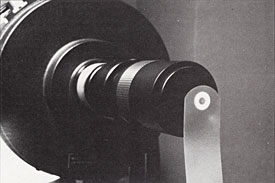
Sky & Telescope photograph
The bottom line for low power is to frame the subject. In fact, the best view occurs with the highest power that comfortably includes the target object. As mentioned before, higher powers darken the background sky, reveal fainter stars, and show more detail. The resulting smaller exit pupil also minimizes the effects of eyesight defects and reduces the size of the dark spot caused by a reflector's central obstruction.
How High Can You Get?
High-power subjects include the Moon, planets, globular star clusters, planetary nebulae, small galaxies, small open clusters, and double stars. Here the power is limited by the atmosphere, telescope aperture and optical quality, the quality of your eyepieces and Barlows, and the stability of the telescope mounting.
A steady atmosphere is a prerequisite for effective high-power observing. Look for a minimum of star twinkling and try to observe subjects high in the sky. Well-made apochromatic and fluorite refractors produce excellent planetary images, and so do traditional long-focus refractors and reflectors with relatively small diagonals. Telescopes of fast focal ratio require complex (and expensive) eyepieces and good-quality Barlows for best results. Barlows can improve image quality and provide more eye relief for comfortable, relaxed high-power viewing.
Also, don't neglect the telescope mounting's rigidity or the smooth drive that is necessary for high-powered observing. A shaky mount can ruin the benefits of an optically excellent instrument. Dobsonians are inherently stable, but they must be moved frequently at a high telescope magnification. This situation can be minimized by using wide-angle eyepieces, which extend the viewing time before having to reposition the instrument.
When telescope magnification gets too high; subjects become dim and lose contrast. They are also more affected by atmospheric seeing and any misalignments and defects in the optics. When using high power, use the "lowest" high power possible.
Image Sharpness
How sharp can you get your telescope magnification? As I noted earlier, Dawes based his resolution limit on his practical viewing experience. But why does a limit exist? Light consists of electromagnetic waves. Just like ripples on a pond when we toss in a few stones, light waves that interact can reinforce in some places and cancel in others. Circular telescope apertures diffract light so that it forms a series of bright and dark rings surrounding a star's image. These are most pronounced if we view the image with the eyepiece slightly inside or outside of focus.
In focus a star's image becomes a small dot with one or more faint diffraction rings around it. Imperfect telescopes and atmospheric turbulence make it difficult to see this pattern. In a perfect image the central dot, called the Airy disk, contains 84 percent of the light collected by the aperture. The first ring has about 7 percent, and the rest is distributed in successively fainter rings.
The 19th-century English physicist Lord Rayleigh established a slightly more lenient resolution limit than Dawes' for double stars. In his view, two stars are just resolvable if the center of one star's Airy disk lies in the first dark ring of the other's diffraction pattern. This Rayleigh limit equals 5.5 arcseconds divided by the telescope aperture in inches. Once you have enough magnification to see the diffraction pattern clearly, further telescope magnification is "empty."
Experienced planetary observers use 20x to 30x per inch of aperture to see the most planetary detail. Double-star observers go higher, up to 50x per inch (which corresponds to a ½-mm exit pupil). Beyond this, telescope magnification power and eye limitations degrade the view.
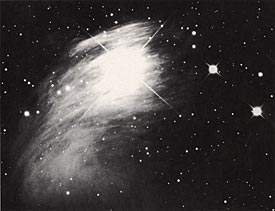
Courtesy Kim Zussman.
The atmosphere limits our sharpness. It is rare to find atmospheric conditions that allow any telescope to perform at more than two or three times the resolution capability of a good 4-inch. Sharpness is not exactly the same as resolution. Spherical aberration, defocusing, or adding a central obstruction subtracts light from the Airy disk and adds it to the diffraction rings.
With a 50% central obstruction, the Airy disk is only 10 times as bright as the first ring, compared to 50 times as bright for an unobstructed telescope. The obstructed system may still split double stars at the Rayleigh limit, but just a touch of atmospheric defocusing will really mess things up.
The shift in light from the Airy disk to the diffraction rings also reduces contrast, rendering planetary details less sharp. Planetary observers using Newtonian reflectors want the smallest possible secondary mirrors for exactly this reason.
Most large reflectors will exhibit better resolution when used with an off-axis aperture mask. You can wait with frustration for those magic, fleeting moments when the atmospheric seeing allows high-resolution glimpses with a large aperture, or you can reduce the aperture and trade off some resolution for much more time when the view is satisfying.
Owners of large Dobsonians find that, for the finest resolution and contrast, an off-axis aperture mask (best placed near the mirror to minimize tube currents) gives the best of all possible worlds — unobstructed, color-free images. A 17-inch mirror can have a 6-inch unobstructed aperture.
Observational astronomy is an aesthetic pursuit for most amateurs. It seems presumptuous to try to quantify how high or low we can go, given the variety of instruments, subjects, atmospheric conditions, and eyesight that exists. I think, however, that two generalizations are valid: For the best low-power views, use the highest power that frames the subject. For the best high-power views, use the lowest power that reveals the detail you're looking for.
 0
0









Comments
You must be logged in to post a comment.